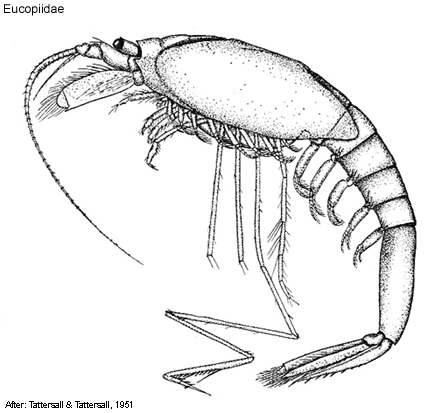 |
||||||
|
|
|
|
|
|
Mysidacea: Families, Subfamilies and TribesKenneth MelandEucopiidae G.O. Sars 1885 Diagnostic description. Head. Carapace large, last 2 or 3 thoracic somites exposed dorsally. Rostrum obtuse. Eyes normally developed. Antenna (antenna 2) scale with apical suture, outer margin smooth, without setae, with terminal spine or without terminal spine. Labrum symmetric. Mandible left mandible lacinia mobilis well developed to lacinia mobilis reduced or absent (right mandible armed with fixed cusp in position of the lacinia mobilis), spine row absent, molar process well developed. Thorax. 1st maxilliped exopod small, unarticulated. 2nd thoracopod developed as a gnathopod, exopod reduced. 3rd thoracopod forming a gnathopod. 4th thoracopod forming a gnathopod. 3rd-8th thoracopods endopod with distinct carpus and propodus, propodus unsegmented. Branchiae on thoracopods present. Marsupium composed of seven pairs of oostegites. Abdomen Abdomen pleural plates absent. 6th & 7th abdominal somites fused. Female pleopods biramous. Uropod endopod setose around entire margin, statocyst absent; exopod with distal articulation, outer margin entire (terminating in distal spines). Telson apex entire to lateral margins constricted. Generic composition. Eucopiidae contains 1 genus (9 species): Eucopia Dana, 1852 (9 species). Remarks. The Eucopiidae are meso-/bathypelagic mysids. Species such as E. unguiculata (W.-Suhm, 1875) and E. grimaldi Nouvel, 1942 are widely distributed in all oceans of the world and abundant from 700-2500 m. As in other Lophogastrida the Eucopidiidae are relatively large (20-60 mm) and have retained several primitive characters: thoracic gills, seven pairs of oostegites,a non-developed right lacinia mobilis, large, natatory female pleopods, and the absence of a statocyst in the uropodal endopod. Unlike Lophogstridae and Gnathophausidae the Eucopiidae carapace is very thin and fragile, also the abdominal pleural plates are reduced as observed in the more derived Mysidacea. Unique for the Eucopiidae are several characters suggesting a raptorial feeding habit seen in reduction of characteristic mouth part features attributed to filter feeding, and the derived nature of the second to fourth thoracopods endopods as gnathopods.
Cite this publication as: 'Meland, K. (2002 onwards). Mysidacea: Families, Subfamilies and Tribes. Version 1: 2 October 2002. https://crustacea.net'. |
|
|
|
|
|
|
|
|
|
Copyright © Australian Museum, 2002 - 2003
Australian Museum website
